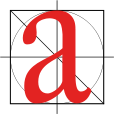- Antiqua (typeface class)
-
 A facsimile of Nicolas Jenson's roman type used in Venice circa 1470. The abstracted long "s" (resembling a barless "f") fell out of use in the 19th century.
A facsimile of Nicolas Jenson's roman type used in Venice circa 1470. The abstracted long "s" (resembling a barless "f") fell out of use in the 19th century.
Antiqua typefaces are those designed between about 1470 and 1600, specifically those by Nicolas Jenson and the Aldine roman commissioned by Aldus Manutius and cut by Francesco Griffo. Antiqua letterforms were modelled on a synthesis of Roman inscriptional capitals and Carolingian writing. They are also known as Venetian types and occasionally as old style, differentiated from modern styles by the more or less uniform thickness of all strokes and by slanted serifs.
Contents
Antiqua Designers
Paul Renner (1878-1956) - Renner Antiqua (1939), Birthplace Wernigerode, Germany. Paul Renner created the Futura (typeface).[1]
Hermann Zapf (born November 8, 1918- ) - Zapf Renaissance Antiqua (1984–1987), Birthplace Nuremberg, Germany. [2] Created many different fonts over the years [3]
Forms and Types of Antiqua
- Zapf Renaissance Antiqua
- Made by Hermann Zapf, Typeface Designer,
- Renner Antiqua
- Made by Paul Renner, Revived by Patrick Strietzel (1939) Crafted at D. Stempel AG Foundry.[4]
- Blackletter
- Antiqua's Germanic opposite is blackletter, in which the letter forms are broken or fractured. In 19th- and 20th-century Germany there was a dispute over whether German should be written in antiqua or the highly-developed Fraktur blackletter. In 1911, the German Reichstag rejected an official switch by only three votes: 85 to 82. Hitler advocated a switch in 1934 but took no action until 1941 when a decree in Germany outlawed the use of blackletter in favour of antiqua See an English Translation of Martin Bormann's 1941 memo mandating the use of Antiqua.
See also
- Bembo
- History of western typography
- Roman type
- Typography
- Old-style figures
References
- Nesbitt, Alexander The History and Technique of Lettering (c) 1957, Dover Publications, Inc. ISBN 0486204278 , Library of Congress Catalogue Card Number: 57-13116. The Dover edition is an abridged and corrected republication of the work originally published in 1950 by Prentice-Hall, Inc. under the title Lettering: The History and Technique of Lettering as Design.
- ^ Linotype, FONT DESIGNER – PAUL RENNER URL: http://www.linotype.com/762/paulrenner.html
- ^ Wikipedia, Hermann Zapf URL: http://en.wikipedia.org/wiki/Hermann_Zapf
- ^ Wikipedia, Hermann Zapf URL:http://en.wikipedia.org/wiki/Hermann_Zapf#List_of_typefaces
- ^ Linotype, RENNER ANTIQUA-Renner Antiqua – Reviving a serif typeface from the designer of Futura – PAUL RENNER URL: http://www.linotype.com/5689/rennerantiqua.html
Typography terminology Page 
Paragraph Character Typeface anatomyCounter · Diacritics · Dingbat · Glyph · Initial · Kerning · Letter-spacing · Ligature · Subscript and superscript · Swash · Text figuresCapitalizationVertical aspectsClassifications Punctuation Typesetting Calligraphy · ETAOIN SHRDLU · Font (Computer font) · Font catalog · Letterpress · Lorem ipsum · Movable type · Pangram · Phototypesetting · Punchcutting · Type design · Typeface · Type foundry · MicrotypographyTypographic units Digital typography Categories:- Typography
- Typography stubs
Wikimedia Foundation. 2010.

